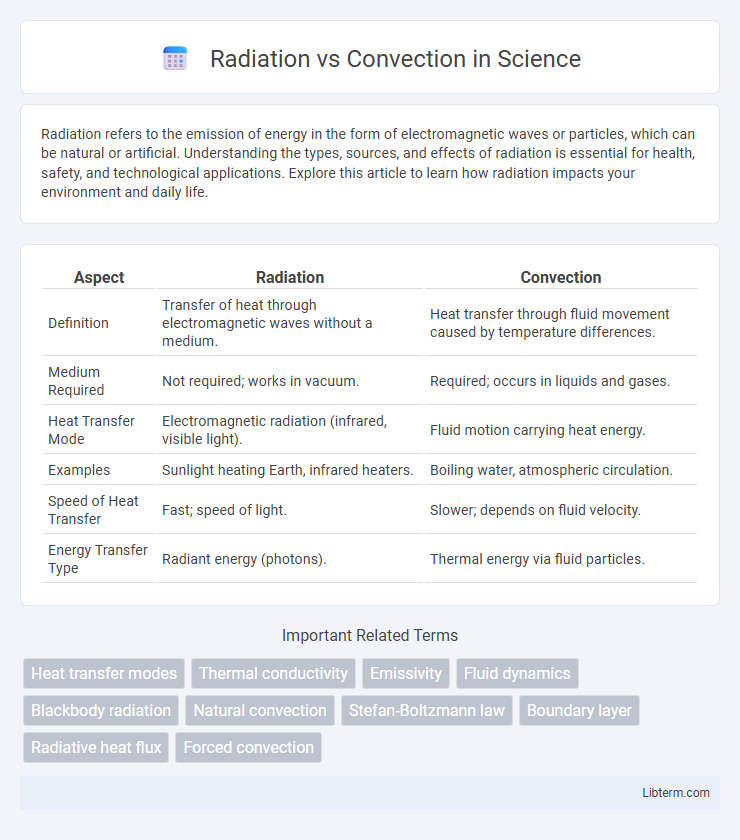Radiation refers to the emission of energy in the form of electromagnetic waves or particles, which can be natural or artificial. Understanding the types, sources, and effects of radiation is essential for health, safety, and technological applications. Explore this article to learn how radiation impacts your environment and daily life.
Table of Comparison
| Aspect | Radiation | Convection |
|---|---|---|
| Definition | Transfer of heat through electromagnetic waves without a medium. | Heat transfer through fluid movement caused by temperature differences. |
| Medium Required | Not required; works in vacuum. | Required; occurs in liquids and gases. |
| Heat Transfer Mode | Electromagnetic radiation (infrared, visible light). | Fluid motion carrying heat energy. |
| Examples | Sunlight heating Earth, infrared heaters. | Boiling water, atmospheric circulation. |
| Speed of Heat Transfer | Fast; speed of light. | Slower; depends on fluid velocity. |
| Energy Transfer Type | Radiant energy (photons). | Thermal energy via fluid particles. |
Introduction to Heat Transfer: Radiation vs Convection
Radiation transfers heat through electromagnetic waves, allowing energy to move across a vacuum without requiring a medium, making it crucial in processes like solar heating and thermal imaging. Convection involves the transfer of heat through fluid motion, where warmer, less dense fluid rises and cooler, denser fluid sinks, playing a significant role in atmospheric phenomena and heating systems. Understanding the distinct mechanisms and applications of radiation and convection is essential for optimizing thermal management in engineering and environmental contexts.
Fundamental Principles of Radiation
Radiation transfers heat through electromagnetic waves without requiring a medium, enabling energy flow even in a vacuum. This process depends on the temperature and emissivity of the radiating surface, governed by the Stefan-Boltzmann law which quantifies radiative heat transfer as proportional to the fourth power of absolute temperature. Unlike convection, which relies on fluid motion to transfer heat, radiation directly emits energy from all objects above absolute zero.
Understanding Convection in Heat Transfer
Convection in heat transfer involves the movement of fluid, such as air or water, transferring thermal energy through both conduction and fluid motion. This process is driven by temperature differences causing fluid density variations, resulting in natural or forced convection currents that enhance heat exchange. Understanding convection requires analyzing factors like fluid velocity, temperature gradients, and the properties of the fluid, which significantly influence heat transfer efficiency.
Key Differences Between Radiation and Convection
Radiation transfers heat through electromagnetic waves and does not require a medium, while convection involves heat transfer through fluid motion, such as air or liquid. Radiation can occur in a vacuum, making it effective for heat transfer in space, whereas convection depends on the physical movement of molecules within gases or liquids to distribute heat. The key difference lies in the mechanism: radiation is energy emission and absorption, whereas convection relies on bulk fluid circulation to transfer thermal energy.
Mechanisms of Energy Transfer in Radiation
Radiation transfers energy through electromagnetic waves, allowing heat to travel through a vacuum without requiring a medium. This mechanism involves the emission of infrared radiation from a hot surface, which is absorbed by cooler objects, raising their temperature. Unlike convection, radiation does not rely on fluid motion but on the propagation of photons, enabling energy exchange across empty space.
Factors Influencing Convection Processes
Convection processes are primarily influenced by temperature gradients, fluid properties such as viscosity and thermal conductivity, and the presence of external forces like gravity or electromagnetic fields. The rate of heat transfer through convection increases with greater temperature differences and enhanced fluid flow or turbulence. Unlike radiation, which relies on electromagnetic waves, convection requires a medium and is significantly affected by fluid dynamics and environmental conditions.
Real-World Applications of Radiative Heat Transfer
Radiative heat transfer plays a crucial role in real-world applications such as solar thermal energy systems, where sunlight is absorbed and converted into usable heat without requiring a medium. Infrared heaters utilize radiation to provide efficient heating in open or large spaces where convection would be less effective due to air movement. Spacecraft thermal control heavily relies on radiative heat transfer to manage temperature in the vacuum of space, where convection is impossible.
Common Uses of Convective Heat Transfer
Convective heat transfer is commonly used in heating and cooling systems such as HVAC units, where air or fluid circulation distributes thermal energy efficiently. Industrial processes like drying, boiling, and chemical reactions rely on convective currents to maintain uniform temperatures and enhance heat exchange. Household appliances, including ovens and refrigerators, exploit convection to improve temperature control and energy efficiency.
Comparative Analysis: Efficiency and Limitations
Radiation transfers heat through electromagnetic waves and is highly efficient in vacuum or transparent mediums, making it ideal for space applications but limited in opaque environments. Convection relies on fluid movement to transfer heat, offering greater efficiency in liquids and gases but facing constraints from fluid viscosity and flow dynamics. Radiation excels in direct energy transmission without a medium, while convection is superior for uniform heating in enclosed spaces.
Conclusion: Choosing Between Radiation and Convection
Choosing between radiation and convection heating depends on the application-specific needs such as energy efficiency, heat distribution, and comfort levels. Radiation provides direct heat transfer ideal for outdoor or spot heating, while convection ensures uniform temperature by circulating warm air in enclosed spaces. Evaluating factors like environment, cost, and desired heating outcomes guides the decision for optimal thermal management.
Radiation Infographic

 libterm.com
libterm.com